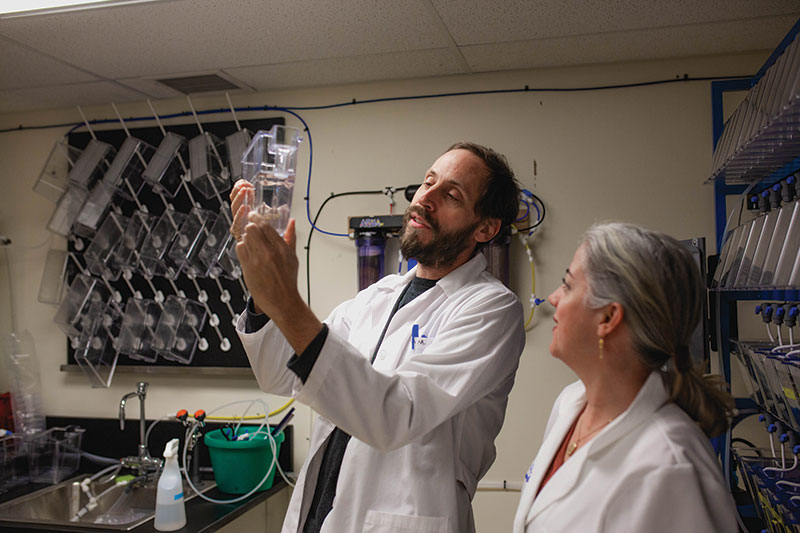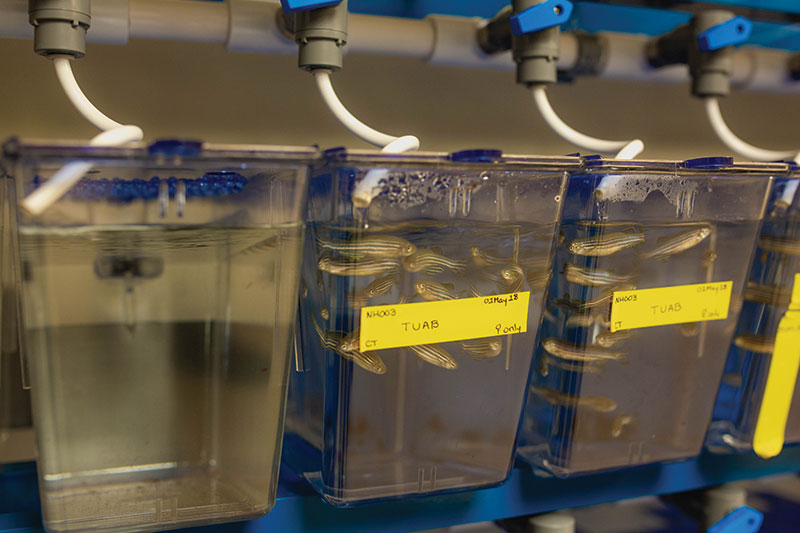
Innovation
Agents of Change
Jonathan Spiegel ’17, Daniel Delgado ’17, Jillian Jacques ’19, and Amanda Arango ’19, define a new generation of innovators and prove that nothing has to be the way it is now.
ALUMNI MAGAZINE
The University of New Haven zebrafish lab boasts 60 tanks, houses as many as 1,000 zebrafish on any given day, and offers countless research opportunities to better our understanding of human health and disease.

The University of New Haven zebrafish lab, installed in August 2018, serves as a core research facility for the biology department. At any given time, 60 tanks are packed to the gills with as many as 1,000 zebrafish. This tropical fish, belonging to the minnow family, is a popular "model organism" for studying biological phenomena, increasing our understanding of human health and disease.
The insights gained from this work will not only give us a better grasp on how cells decide when to divide, move, and differentiate, but they will also shed light on how genetic mutations can cause these same processes to go awry. The zebrafish genome has been fully sequenced to a very high quality. This has enabled scientists to create mutations in thousands of genes to study their function.
Read on for more information about current faculty-mentored research projects being overseen by Dr. Carter Takacs, assistant professor in the Department of Biology and Environmental Science.
Did you know? Zebrafish have a counterpart for 84% of human genes.

Recent work has shown that microRNAs — a class of small, well-conserved molecules that have been demonstrated to regulate numerous biological pathways and cellular functions — play a critical role in ensuring that the brain forms properly. Previous work by Takacs and colleagues has revealed that the loss of one particular microRNA — miR-430 — leads to abnormal neural tube development in zebrafish. Student researchers will be studying the role that this microRNA plays in neural development for the zebrafish with the hope that this will create a more informed perspective on this same phenomenon in humans. To do this, they will couple genetic techniques with fluorescence microscopy to assess brain formation in vivo.
Large-scale human population studies have identified specific gene variants that are associated with autism. The Takacs Lab, in collaboration with the Hoffman Lab at Yale University, is studying the function of one of these genes — ADNP — in brain development and behavior in zebrafish. These efforts will help researchers better understand what roles this gene may play in humans. To do this, students are modifying the ADNP gene in zebrafish and measuring the consequences on brain development and structure. By better understanding how brain function is altered in autism, this work has the potential to open up new therapeutic strategies for treatment.
Students are modifying the ADNP gene in zebrafish and measuring the consequences on brain development and structure.

We all begin our journey in life as single fertilized cells that divide into millions of progeny cells. Our transformation into complex bodies involves dynamic and coordinated changes in which genes are turned on and off as development proceeds. The Takacs Lab is interested in understanding how this precise regulation occurs. Since zebrafish embryos develop outside their mother, these events can be visualized with ease. Further, new technological advances allow Takacs’ students to make specific changes to the genome and measure the effects on development. This research will not only illuminate our understanding of life’s beginnings, but will also provide insights toward diagnosing, preventing, and treating human birth defects.
The work in the Takacs Lab involves genetic editing techniques that would have been inconceivable at a smaller, primarily undergraduate university less than 10 years ago. CRISPR, a powerful gene-editing technology, lets scientists "cut and paste" pieces of DNA from genes, making it possible to repair defective genes and possibly cure diseases. What’s more, when CRISPR is applied to zebrafish, one can often see research results in as little as a few days. The advent of this technology has enabled Takacs’ students to change the genetic blueprint of the zebrafish and modify the genome in precise ways in order to study the genetic basis of development, as well as diseases such as cancer.
Students change the genetic blueprint of the zebrafish and modify the genome to study the genetic basis of development.


Jonathan Spiegel ’17, Daniel Delgado ’17, Jillian Jacques ’19, and Amanda Arango ’19, define a new generation of innovators and prove that nothing has to be the way it is now.

In advance of our Centennial in 2020, we took the University of New Haven on the road, hosting a series of signature events to commemorate this milestone anniversary.

Tim Ryan ’94, EMBA ’96, head of the Culinary Institute of America, believes in working hard and eating well.